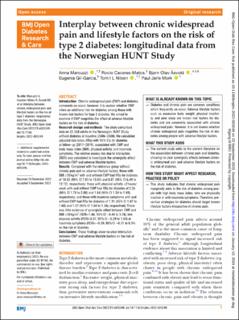| dc.contributor.author | Marcuzzi, Anna | |
| dc.contributor.author | Caceres-Matos, Rocio | |
| dc.contributor.author | Åsvold, Bjørn Olav | |
| dc.contributor.author | Gil-Garcia, Eugenia | |
| dc.contributor.author | Nilsen, Tom Ivar Lund | |
| dc.contributor.author | Mork, Paul Jarle | |
| dc.date.accessioned | 2024-02-05T14:50:22Z | |
| dc.date.available | 2024-02-05T14:50:22Z | |
| dc.date.created | 2023-10-09T09:02:26Z | |
| dc.date.issued | 2023 | |
| dc.identifier.citation | BMJ Open Diabetes Research & Care. 2023, 11 (5), e003249. | en_US |
| dc.identifier.issn | 2052-4897 | |
| dc.identifier.uri | https://hdl.handle.net/11250/3115687 | |
| dc.description.abstract | Introduction: Chronic widespread pain (CWP) and diabetes commonly co-occur; however, it is unclear whether CWP infers an additional risk for diabetes among those with known risk factors for type 2 diabetes. We aimed to examine if CWP magnifies the effect of adverse lifestyle factors on the risk of diabetes.
Research design and methods: The study comprised data on 25 528 adults in the Norwegian HUNT Study without diabetes at baseline (2006–2008). We calculated adjusted risk ratios (RRs) with 95% CIs for diabetes at follow-up (2017–2019), associated with CWP and body mass index (BMI), physical activity, and insomnia symptoms. The relative excess risk due to interaction (RERI) was calculated to investigate the synergistic effect between CWP and adverse lifestyle factors.
Results: Compared with the reference group without chronic pain and no adverse lifestyle factors, those with BMI ≥30 kg/m2 with and without CWP had RRs for diabetes of 10.85 (95% CI 7.83 to 15.05) and 8.87 (95% CI 6.49 to 12.12), respectively; those with physical activity <2 hours/week with and without CWP had RRs for diabetes of 2.26 (95% CI 1.78 to 2.88) and 1.54 (95% CI 1.24 to 1.93), respectively; and those with insomnia symptoms with and without CWP had RRs for diabetes of 1.31 (95% CI 1.07 to 1.60) and 1.27 (95% CI 1.04 to 1.56), respectively. There was little evidence of synergistic effect between CWP and BMI ≥30 kg/m2 (RERI=1.66, 95% CI −0.44 to 3.76), low physical activity (RERI=0.37, 95% CI −0.29 to 1.03) or insomnia symptoms (RERI=−0.09, 95% CI −0.51 to 0.34) on the risk of diabetes.
Conclusions: These findings show no clear interaction between CWP and adverse lifestyle factors on the risk of diabetes. | en_US |
| dc.language.iso | eng | en_US |
| dc.publisher | BMJ Publishing Group Ltd | en_US |
| dc.rights | Navngivelse-Ikkekommersiell 4.0 Internasjonal | * |
| dc.rights.uri | http://creativecommons.org/licenses/by-nc/4.0/deed.no | * |
| dc.title | Interplay between chronic widespread pain and lifestyle factors on the risk of type 2 diabetes: longitudinal data from the Norwegian HUNT Study | en_US |
| dc.title.alternative | Interplay between chronic widespread pain and lifestyle factors on the risk of type 2 diabetes: longitudinal data from the Norwegian HUNT Study | en_US |
| dc.type | Peer reviewed | en_US |
| dc.type | Journal article | en_US |
| dc.description.version | publishedVersion | en_US |
| dc.source.pagenumber | 0 | en_US |
| dc.source.volume | 11 | en_US |
| dc.source.journal | BMJ Open Diabetes Research & Care | en_US |
| dc.source.issue | 5 | en_US |
| dc.identifier.doi | 10.1136/bmjdrc-2022-003249 | |
| dc.identifier.cristin | 2182727 | |
| cristin.ispublished | true | |
| cristin.fulltext | original | |
| cristin.qualitycode | 1 | |

